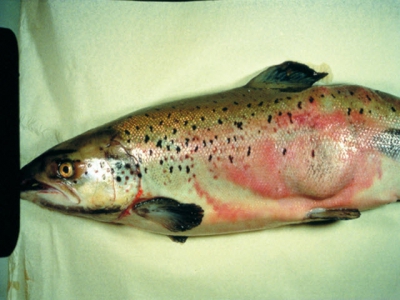Fish disease guide - Furunculosis

What is it?
Furunculosis is highly contagious disease that affects fish of all ages. Also known as infection with Aeromonas salmonicida, the infection causes high mortality in salmonids, though some other species of fish are affected.
Furunculosis in Atlantic salmon (Salmo salar); note the large furuncle (boil) on the side of the fish
Where and When Might it Occur?
The disease one of the most commercially significant salmonid diseases, occurring in freshwater and marine salmonid aquaculture in all countries except Australia and New Zealand.
Outbreaks typically occur at temperatures above 10C, however outbreaks can occur in very young fish and at temperatures as low as 24C. Disease may be precipitated by endogenous (e.g. smoltification, spawning) and exogenous (e.g. temperature fluctuations, poor water quality) stressors.
Horizontal transmission occurs via the water column, but also through direct fish-to-fish contact and animal vectors (birds and invertebrates such as sea lice).
Non-salmonids may become infected by ingesting tissue of infected salmonids. Similarly, transmission to non-salmonids can occur where fish caught for feed are taken from waters near an outbreak.
Susceptibility to the disease increases with damaged mucous and skin, such as occurs when fish are handled with nets.
Fish surviving disease outbreaks are recognised as carriers of the disease and may continue to infect the remaining population without themselves showing any outward signs of infection.
Diagnosis
Furunculosis causes high mortality in fish, with death coming a matter of days after symptoms appearing.
Sudden death, perhaps with slight exophthalmos (popeye) can be observed.
Fish may also show lethargic swimming or swimming just below the surface, loss of appetite, respiratory distress or jumping from the water.
Gross pathological signs are:
• furuncles (or boils) involving skin and/or muscle, progressing to crater lesions (usually restricted to the subacute or chronic phase in adult salmon)
• haemorrhages on the skin, mouth and fin bases (mainly of paired fins)
• darkening of body colour and pale gills
• bloody discharge from nares and/or vent
• exophthalmos (popeye)
• haemorrhages in muscle and internal organs
• enlarged spleen and focal necrosis of the liver
• stomach filled with mucus, blood and sloughed epithelial cells
• congested intestine
• death without any clinical signs other than darkening of the skin, which can occur in peracute infections in juvenile salmon.

Furunculosis in Atlantic salmon (Salmo salar); note the furuncle cut away to show the underlying necrotic tissue
Microscopic pathological signs are:
• fusion of gill lamellae, with necrosis of the epithelium
• eosinophilic inflammatory changes in gills
• bacterial colonies in many tissues
• sloughing of renal tubular cells into the renal tubular lumen
• sloughing of intestinal epithelial cells into the intestinal lumen.
Control/ Treatment
The disease is controlled on farms by medication or vaccination.
Iodine is also used to decontaminate the surface of fertilised eggs to prevent vertical transmission (passage of infection from parent to offspring).
Related news
Tools

Phối trộn thức ăn chăn nuôi

Pha dung dịch thủy canh

Định mức cho tôm ăn

Phối trộn phân bón NPK

Xác định tỷ lệ tôm sống

Chuyển đổi đơn vị phân bón

Xác định công suất sục khí

Chuyển đổi đơn vị tôm

Tính diện tích nhà kính

Tính thể tích ao



 Alabama catfish, feed producer files for bankruptcy
Alabama catfish, feed producer files for bankruptcy  Fish disease guide - Gyrodactylus Salaris
Fish disease guide - Gyrodactylus Salaris